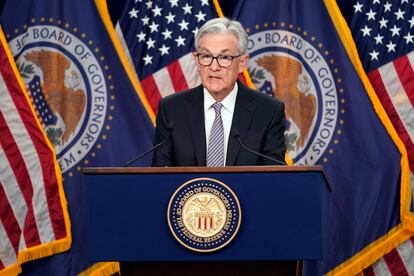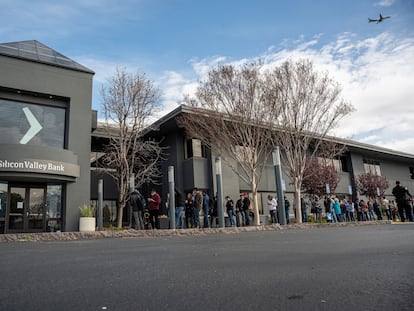Federal Reserve raises interest rates again, but hints it may pause amid bank turmoil
The Fed’s 10 consecutive rate increases over the past 14 months have more than doubled mortgage rates, elevated the costs of auto loans, credit card borrowing and business loans and heightened the risk of a recession

The Federal Reserve reinforced its fight against high inflation Wednesday by raising its key interest rate by a quarter-point to the highest level in 16 years. But the Fed also signaled that it may now pause the streak of 10 rate hikes that have made borrowing for consumers and businesses steadily more expensive.
In a statement after its latest policy meeting, the Fed removed a previous sentence that had said “some additional” rate hikes might be needed. It replaced it with language that said it will consider a range of factors in “determining the extent” to which future hikes might be needed.
The Fed’s rate increases over the past 14 months have more than doubled mortgage rates, elevated the costs of auto loans, credit card borrowing and business loans and heightened the risk of a recession. Home sales have plunged as a result. The Fed’s latest move, which raised its benchmark rate to roughly 5.1%, could further increase borrowing costs.
Still, the Fed’s statement offered little indication that its string of rate hikes have made significant progress toward its goal of cooling the economy, the job market and inflation. Inflation has fallen from a peak of 9.1% in June to 5% in March but remains well above the Fed’s 2% target rate.
“Job gains have been robust in recent months, and the unemployment rate has remained low,” the statement said. “Inflation remains elevated.”
The surge in rates has contributed to the collapse of three large banks and turmoil in the banking industry. All three failed banks had bought long-term bonds that paid low rates and then rapidly lost value as the Fed sent rates higher.
The banking upheaval might have played a role in the Fed’s decision Wednesday to consider a pause. Chair Jerome Powell had said in March that a cutback in lending by banks, to shore up their finances, could act as the equivalent of a quarter-point rate hike in slowing the economy.
Fed economists have estimated that tighter credit resulting from the bank failures will contribute to a “mild recession” later this year, thereby raising the pressure on the central bank to suspend its rate hikes.
The Fed is now also grappling with the threat of a prolonged standoff around the nation’s borrowing limit, which caps how much debt the government can issue. Congressional Republicans are demanding steep spending cuts as the price of agreeing to lift the nation’s borrowing cap.
The Fed’s decision Wednesday came against an increasingly cloudy backdrop. The economy appears to be cooling, with consumer spending flat in February and March, indicating that many shoppers have grown cautious in the face of higher prices and borrowing costs. Manufacturing, too, is weakening.
Even the surprisingly resilient job market, which has kept the unemployment rate near 50-year lows for months, is showing cracks. Hiring has decelerated, job postings have declined and fewer people are quitting their jobs for other, typically higher-paying positions.
The turmoil in the nation’s banking sector, which re-erupted last weekend as regulators seized and sold off First Republic Bank, has intensified the pressure on the economy. It was the second-largest U.S. bank failure ever and the third major banking collapse in the past six weeks. Investors have grown anxious about whether other regional banks may suffer from similar problems.
Goldman Sachs estimates that a widespread pullback in bank lending could cut U.S. growth by 0.4 percentage point this year. That could be enough to cause a recession. In December, the Fed projected growth of just 0.5% in 2023.
Wall Street traders were also unnerved by this week’s announcement from Treasury Secretary Janet Yellen that the nation could default on its debt as soon as June 1 unless Congress agrees to lift the debt limit, which caps how much the government can borrow. A first-ever default on the U.S. debt could potentially lead to a global financial crisis.
The Fed’s rate hike Wednesday comes as other major central banks are also tightening credit. European Central Bank President Christine Lagarde is expected to announce another interest rate increase Thursday, after inflation figures released Tuesday showed that price increases ticked up last month.
Consumer prices rose 7% in the 20 countries that use the euro currency in April from a year earlier, up from a 6.9% year-over-year increase in March.
In the United States, some major drivers of higher prices have stalled or started to reverse, causing slowdowns in overall inflation. The consumer price index rose 5% in March from a year earlier, sharply lower than its 9.1% peak in June.
The rise in rental costs has eased as more newly built apartments have come online. Gas and energy prices have fallen steadily. Food costs are moderating. Supply chain snarls are no longer blocking trade, thereby lowering the cost for new and used cars, furniture and appliances.
Still, while overall inflation has cooled, “core” inflation — which excludes volatile food and energy costs — has remained chronically high. According to the Fed’s preferred measure, core prices rose 4.6% in March from a year earlier, scarcely better than the 4.7% it reached in July.
Sign up for our weekly newsletter to get more English-language news coverage from EL PAÍS USA Edition
Tu suscripción se está usando en otro dispositivo
¿Quieres añadir otro usuario a tu suscripción?
Si continúas leyendo en este dispositivo, no se podrá leer en el otro.
FlechaTu suscripción se está usando en otro dispositivo y solo puedes acceder a EL PAÍS desde un dispositivo a la vez.
Si quieres compartir tu cuenta, cambia tu suscripción a la modalidad Premium, así podrás añadir otro usuario. Cada uno accederá con su propia cuenta de email, lo que os permitirá personalizar vuestra experiencia en EL PAÍS.
¿Tienes una suscripción de empresa? Accede aquí para contratar más cuentas.
En el caso de no saber quién está usando tu cuenta, te recomendamos cambiar tu contraseña aquí.
Si decides continuar compartiendo tu cuenta, este mensaje se mostrará en tu dispositivo y en el de la otra persona que está usando tu cuenta de forma indefinida, afectando a tu experiencia de lectura. Puedes consultar aquí los términos y condiciones de la suscripción digital.
More information
Archived In
Últimas noticias
Most viewed
- Sinaloa Cartel war is taking its toll on Los Chapitos
- Oona Chaplin: ‘I told James Cameron that I was living in a treehouse and starting a permaculture project with a friend’
- Reinhard Genzel, Nobel laureate in physics: ‘One-minute videos will never give you the truth’
- Why the price of coffee has skyrocketed: from Brazilian plantations to specialty coffee houses
- Silver prices are going crazy: This is what’s fueling the rally










































